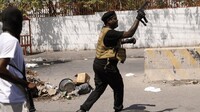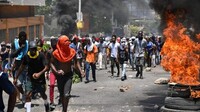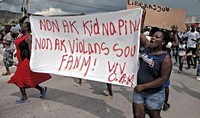Haiti : le forze di occupazione dell' ONU fanno un massacro di poveri a Port-au-Prince
According to accounts from many different members of the community, many
of whom chose to remain anonymous, as well as from journalists who were on
the scene during the operation, UN forces surrounded two neighborhoods
within Cite Soleil, Boisneuf and Project Drouillard, sealing off the
alleys with tanks and troops.
Two helicopters flew overhead. At 4:30 AM, UN forces launched the
offensive, shooting into houses, shacks, a church, and a school with
machine guns, tank fire, and tear gas. Eyewitnesses reported that when
people fled to escape the tear gas, UN troops gunned them down from the
back.
UN forces shot out electric transformers in the neighborhood. People were
killed in their homes and also just outside of their homes, on the way to
work. According to journalists and eyewitnesses, one man named Leon
Cherry, age 46, was shot and killed on his way to work for a flower
company. Another man, Mones Belizaire, was shot as he got ready to go work
in a local sweatshop and subsequently died from a stomach infection. A
woman who was a street vendor was shot in the head and killed instantly.
One man was shot in his ribs while he was trying to brush his teeth.
Another man was shot in the jaw as he left his house to try and get some
money for his wife's medical costs; he endured a slow death.Yet another
man named Mira was shot and killed while urinating in his home.
A mother, Sena Romelus, and her two young children were killed in their
home, either by bullets or by a 83-CC grenade UN forces threw. Film
footage of many of these deaths was shared with the US human rights
delegation. Eyewitnesses claimed that the offensive overwhelmed the
community and that there was not a "firefight", but rather a slaughter.
The operation was primarily conducted by UN forces, with the Haitian
National Police this time taking a back seat.
Seth Donnelly, a member of the US human rights delegation in
Port-au-Prince, visited Cite Soleil with Haitian human rights workers on
Thursday afternoon, July 7th. The team gathered testimony from many
members of the community, young and old, men, women, and youth. All
verified the previous statements we had received from journalists and
other eyewitness accounts.
These community members spoke of how they had been surrounded by tanks and
troops that sealed off exits from the neighborhoods and then proceeded to
assault the civilian population. The community allowed the team to film
the evidence of the massacre, showing the homes -- in some cases made of
tin and cardboard -- that had been riddled by bullets, tank fire and
helicopter ammunition, as well as showing the team some of the corpses
still there, including a mother and her two children.
The team also filmed a church and a school that had been riddled by
ammunition. Reportedly, a preacher was among the victims killed. Some
community members allowed the team to interview them, but not to film
their faces for fear of their lives. People were traumutized and, in the
cases of loved ones of victims, hysterical.
Many community members -- again young and old, men and women -- spoke
highly of Dread Wilme, referring to him as their "protector" or "father",
and expressed fear for the future. One member said that he heard that
another UN operation against the community was planned for later Thursday
night or early Friday morning.
Multiple community people indicated that they had counted at least 23
bodies of people killed by the UN forces. Community members claimed that
UN forces had taken away some of the bodies. Published estimates indicate
that upwards of 50 may have been killed and an indeterminate number
wounded, and that more than 300 heavily armed UN troops took part in the
assault on this densely populated residential neighborhood.
"There was systematic firing on civilians," said one eyewitness to the
killing. "All exits were cut off. The community was choked off,
surrounded -- facing tanks coming from different angles, and overhead,
helicopters with machine guns fired down on the people. The citizens were
under attack from all sides and from the air. It was war on a community."
The Labor/Human Rights Delegation from the United States, initiated by the
San Francisco Labor Council, had been in Haiti since late last month to
attend the Congress of the Confederation of Haitian Workers (CTH), the
country's largest labor organization, and met with hundreds of Haitian
workers, farmers and professionals about the current labor and human
rights situation in Haiti.
Articoli correlati
 La Missione multinazionale di sostegno alla sicurezza, presieduta dal Kenya, sembra inadeguata
La Missione multinazionale di sostegno alla sicurezza, presieduta dal Kenya, sembra inadeguataLa lenta agonia di Haiti
Il paese è in preda al caos e alla violenza, tanto da essere definito la “Striscia di Gaza del Caribe”3 febbraio 2025 - David Lifodi Sottomesso ancora oggi alle politiche coloniali, il paese è divenuto uno stato fallito
Sottomesso ancora oggi alle politiche coloniali, il paese è divenuto uno stato fallitoHaiti: un paese a sovranità limitata
Tra i responsabili, la criminalità organizzata, gli Usa e tutte quelle dittature e interventi stranieri che si susseguono in questo poverissimo paese provocando un'emergenza politica e umanitaria.6 maggio 2024 - David Lifodi I lavoratori di Haiti
I lavoratori di HaitiIn solidarietà con i lavoratori e i migranti di Haiti
Dichiarazione della Black Alliance for Peace14 dicembre 2022 - The Black Alliance for Peace

Sociale.network